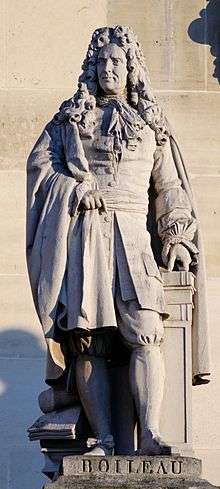Charles Émile Seurre
Charles Marie Émile Seurre or Seurre the Younger (22 February 1798 – 11 January 1858) was a French sculptor.[1]

Nicolas Boileau by Seurre the Younger, cour Napoléon of the palais du Louvre
Life
Seurre was born and died in Paris. A student of the sculptor Pierre Cartellier, in 1824 Émile Seurre won the Prix de Rome for sculpture with a relief on the subject Joseph's tunic brought back to Jacob. Like his elder brother Bernard Seurre, he took part in spreading the Napoleonic legend and is best known for his series of statues of 'great men'.
Works
- Napoleon I (1833), standing statue, bronze, Paris, Hôtel des Invalides, cour d'honneur
- Napoléon I, standing statue (smaller version), bronze, Versailles, châteaux de Versailles et de Trianon
- The Navy, allegorical figure, Paris, Arc de Triomphe de l'Étoile, under the arc de triomphe, north spandrel
- Talent, statue, Paris, Père Lachaise Cemetery, tomb of Pierre Cartellier, left side
- A stela with three veiled figures, bas-relief, Paris, cimetière du Père-Lachaise, tomb of Pierre Cartellier, to the right of the tomb
- Portrait of Hugues Quiéret, admiral of France (died 1340) (1840), bust, plaster, Versailles, châteaux de Versailles et de Trianon
- Saint Louis, standing statue, Versailles, châteaux de Versailles et de Trianon
- Gaston de Foix, duc de Nemours (1489 - 1512) (1842), standing statue, marble, Versailles, châteaux de Versailles et de Trianon
- Charles VII, standing statue, marble, Versailles, châteaux de Versailles et de Trianon
- Statue of the young Romain at the musée Crozatier du Puy-en-Velay.
Sources
- Ward-Jackson, Philip (1996). "Seurre" in The Dictionary of Art, edited by Jane Turner; vol. 28, p. 506. London: Macmillan. Reprinted 1998 with minor corrections: ISBN 9781884446009.
- (in French) Simone Hoog, (preface by Jean-Pierre Babelon, with Roland Brossard), Musée national de Versailles. Les sculptures. I- Le musée, Réunion des musées nationaux, Paris, 1993
- (in French) Pierre Kjellberg, Le Nouveau guide des statues de Paris, La Bibliothèque des Arts, Paris, 1988
- (in French) Emmanuel Schwartz, Les Sculptures de l'École des Beaux-Arts de Paris. Histoire, doctrines, catalogue, École nationale supérieure des Beaux-Arts, Paris, 2003
gollark: Except it isn't really.
gollark: I mean, outside of toy models or whatever.
gollark: Maybe you could make a good scifi thing a hundred years in the future or something about faster computers/better optimization algorithms/distributed system designs/something making central planning more tractable. Although in the future supply chains will probably be even more complex. But right now, it is NOT practical.
gollark: In any case, if you have a planned system and some new need comes up... what do you do, spend weeks updating the models and rerunning them? That is not really quick enough.
gollark: If you want to factor in each individual location's needs in some giant model, you'll run into issues like:- people lying- it would be horrifically complex
This article is issued from Wikipedia. The text is licensed under Creative Commons - Attribution - Sharealike. Additional terms may apply for the media files.